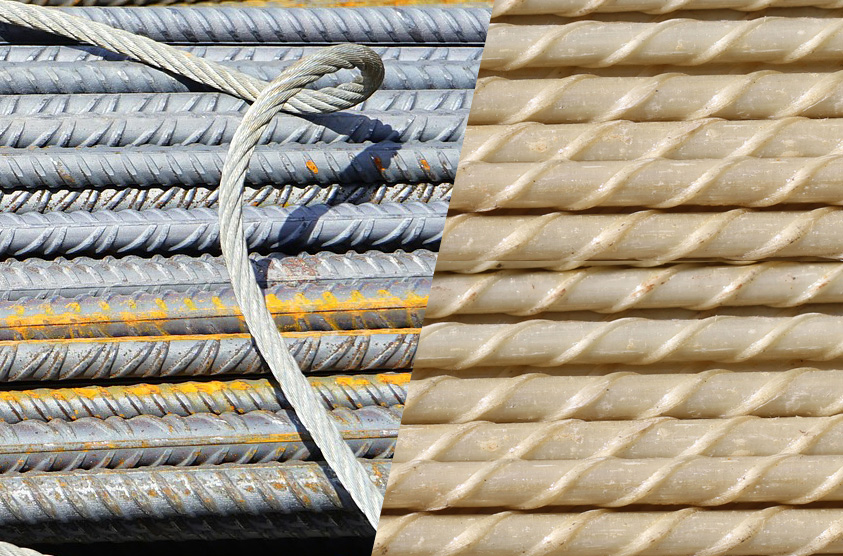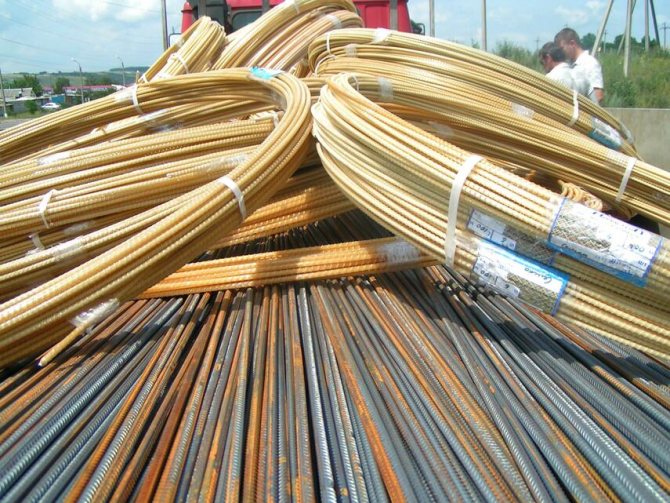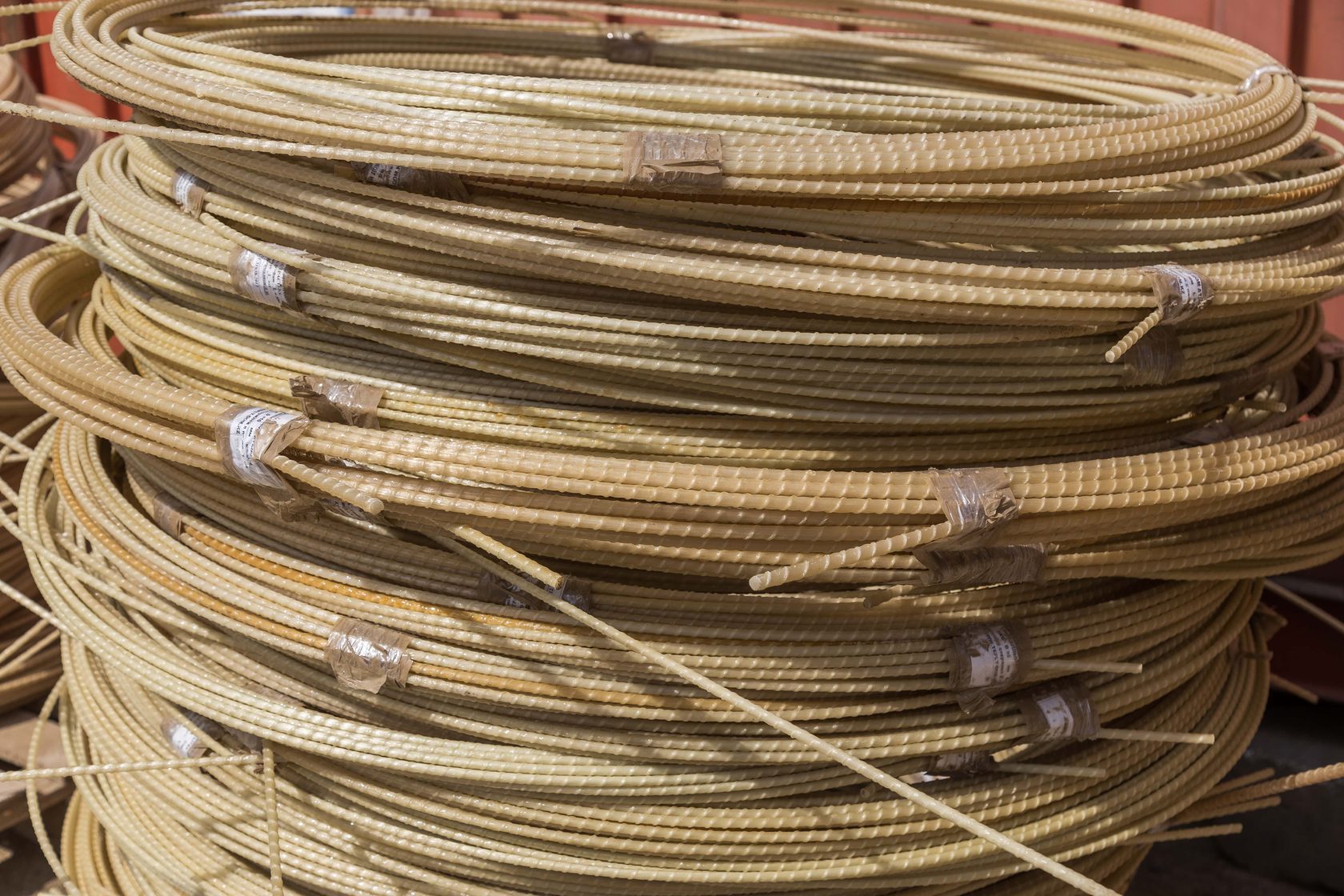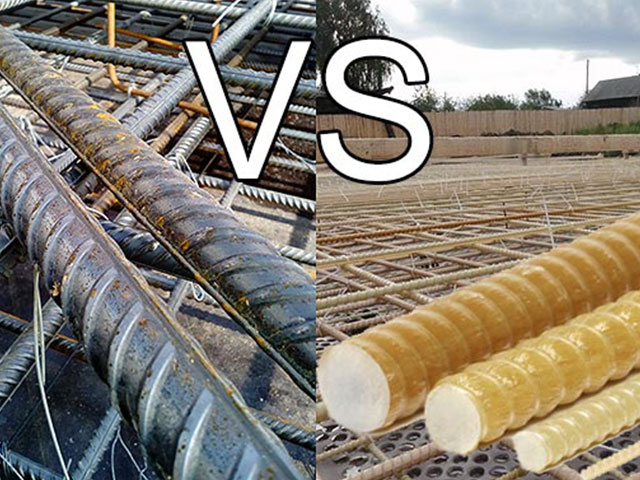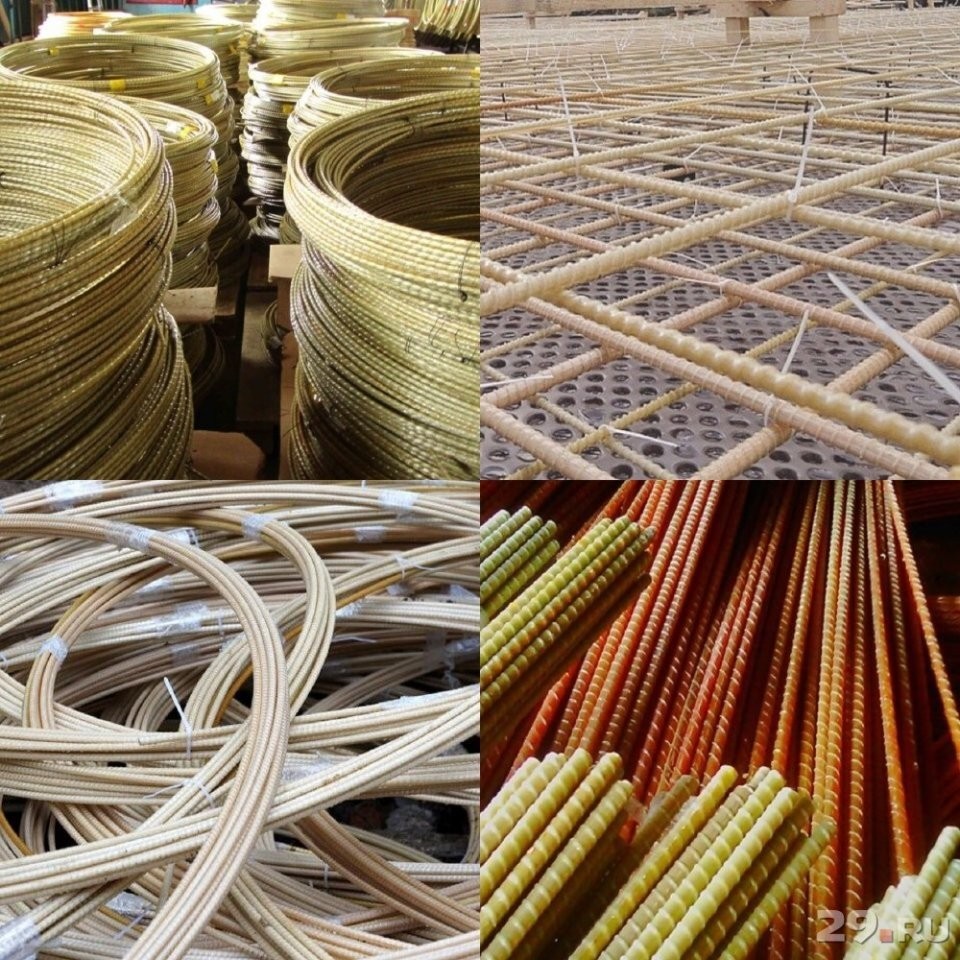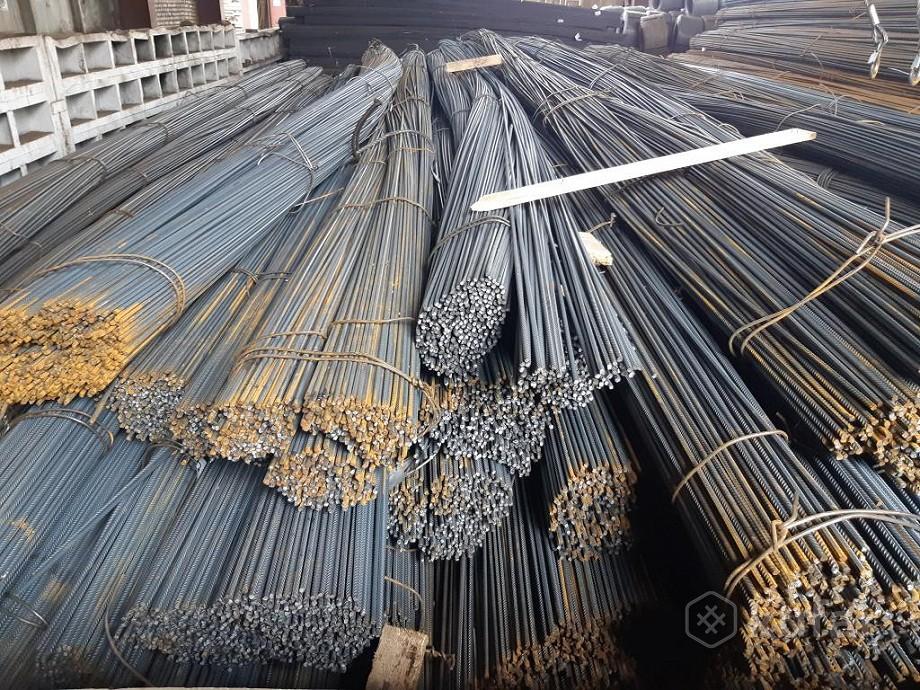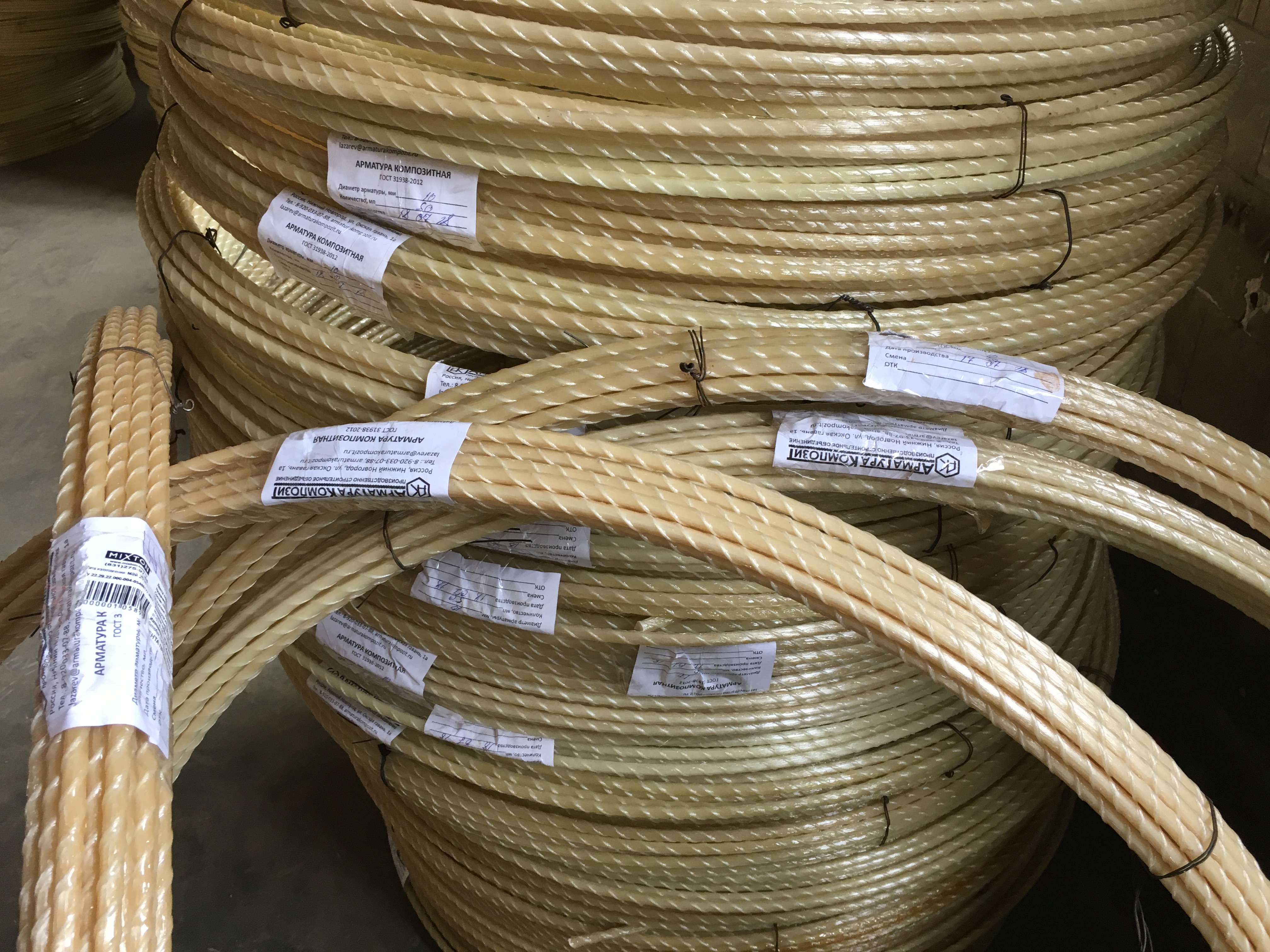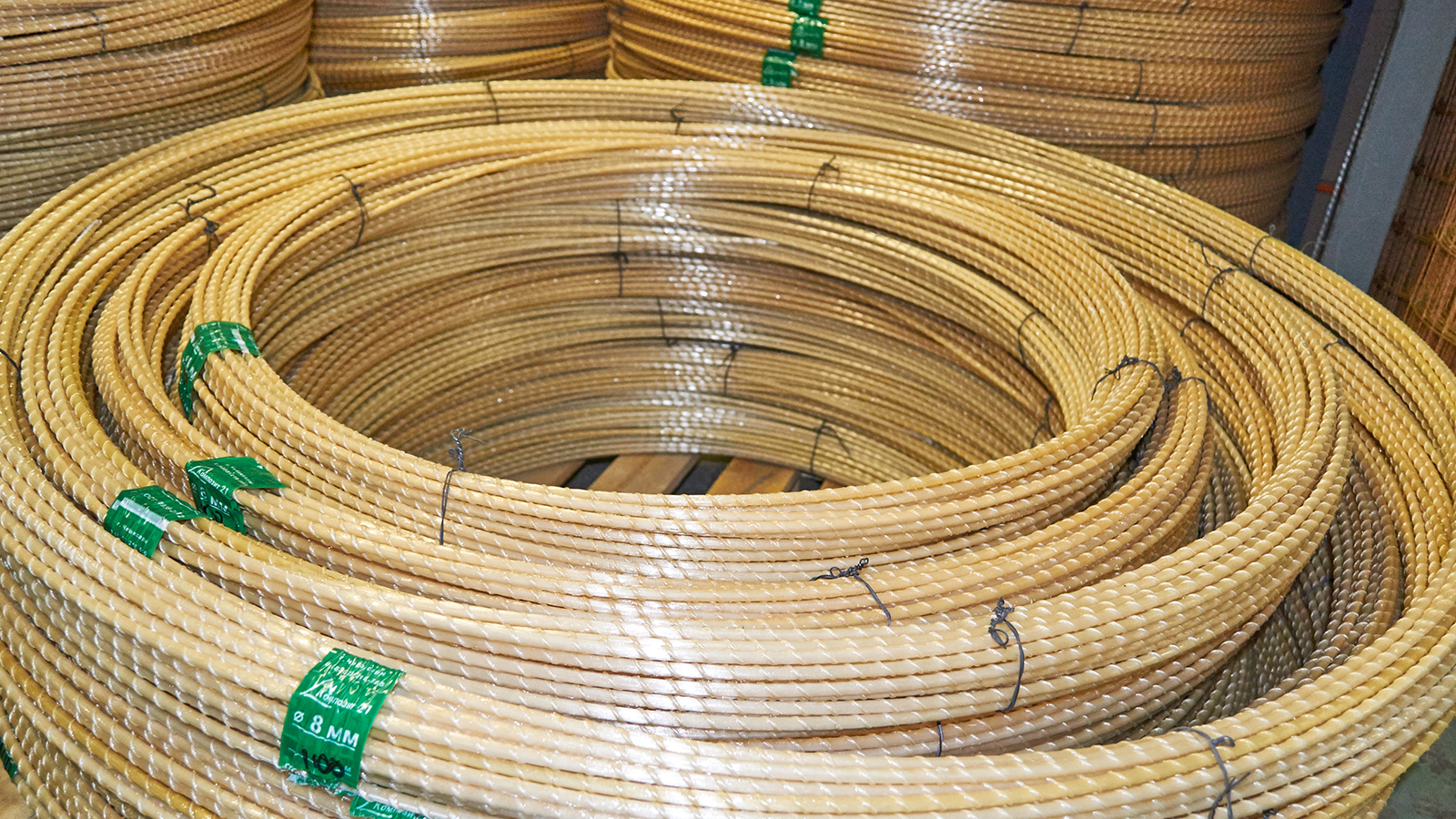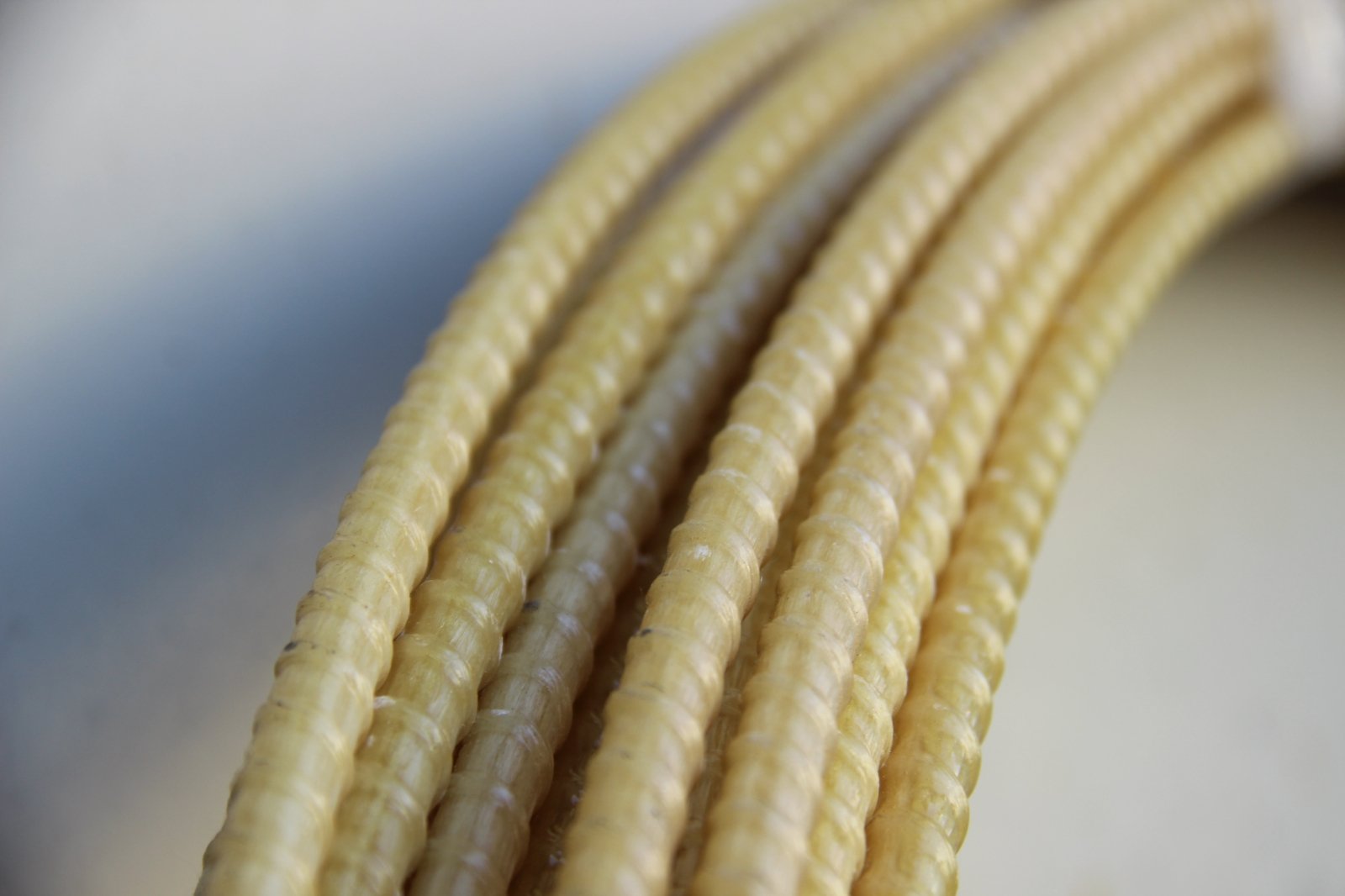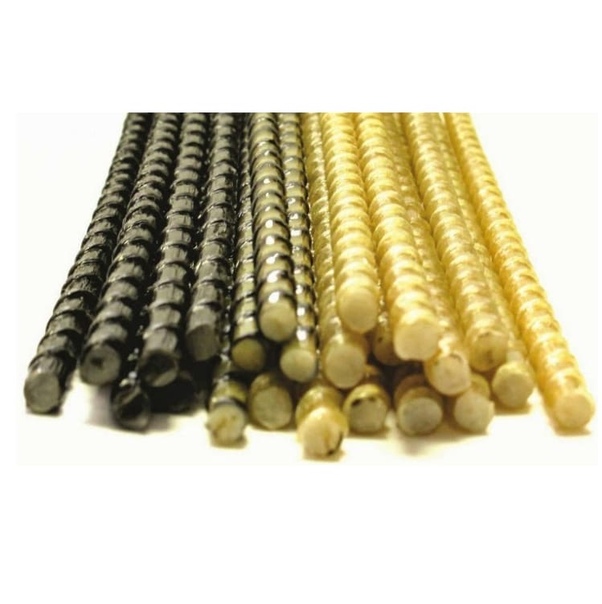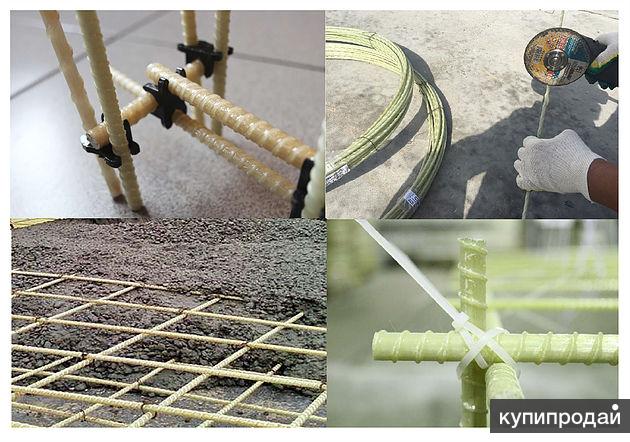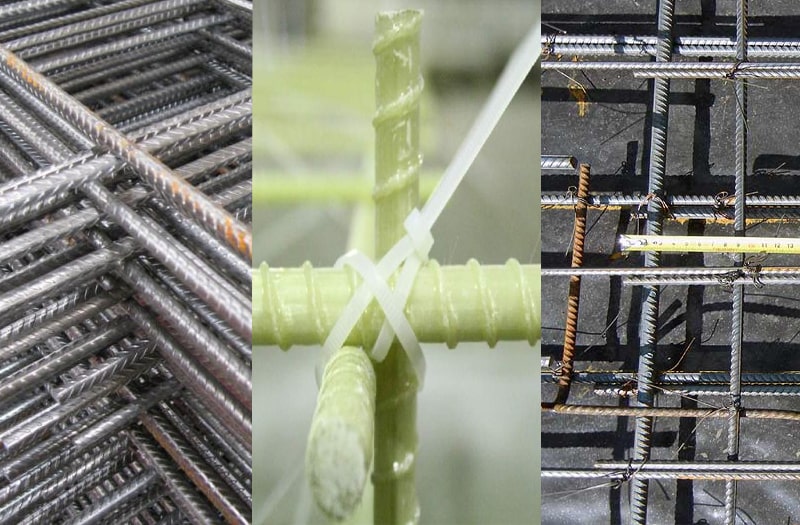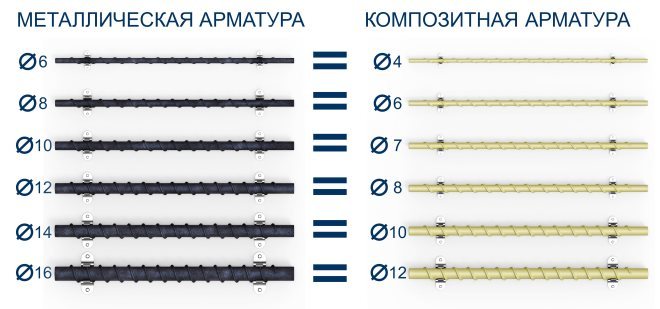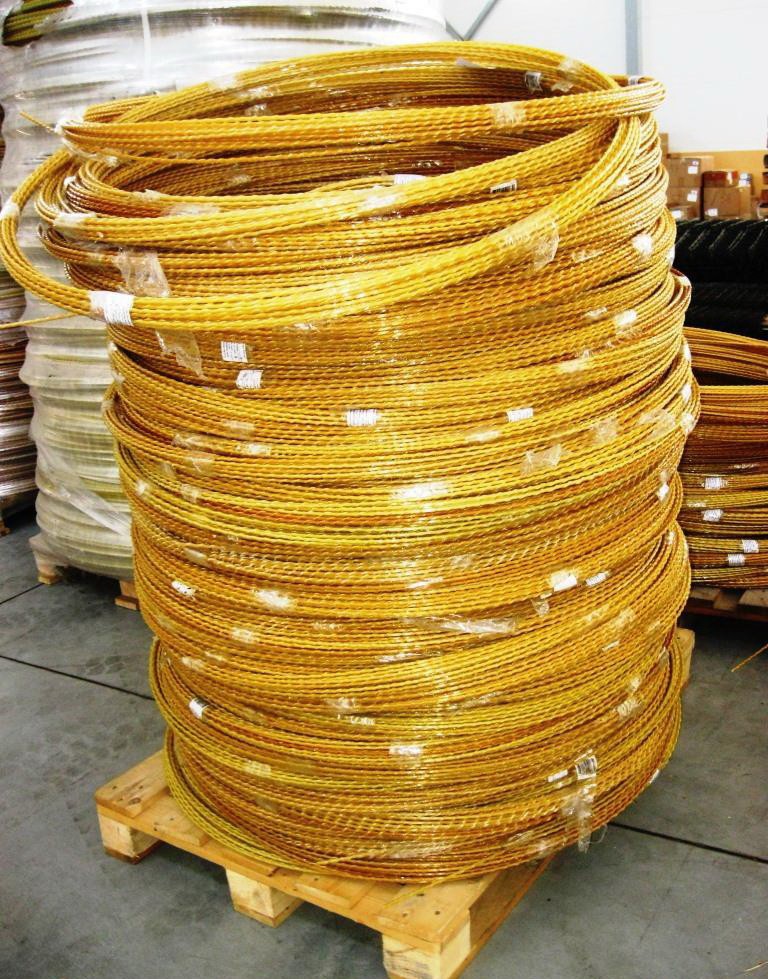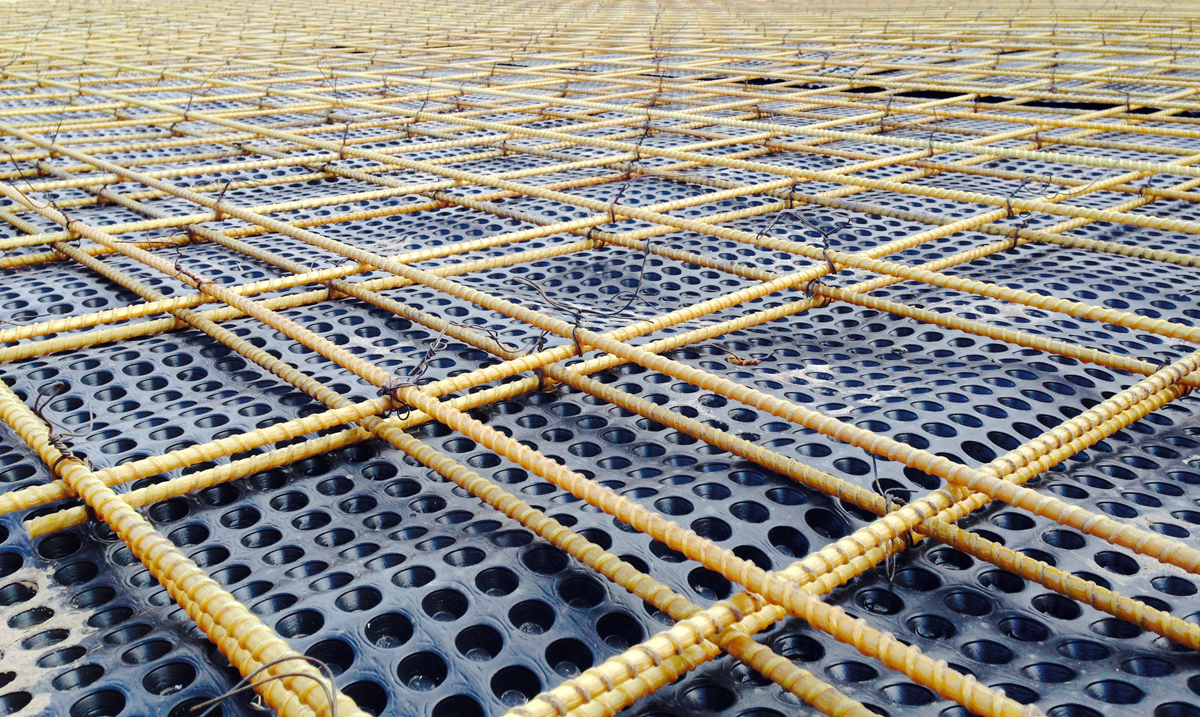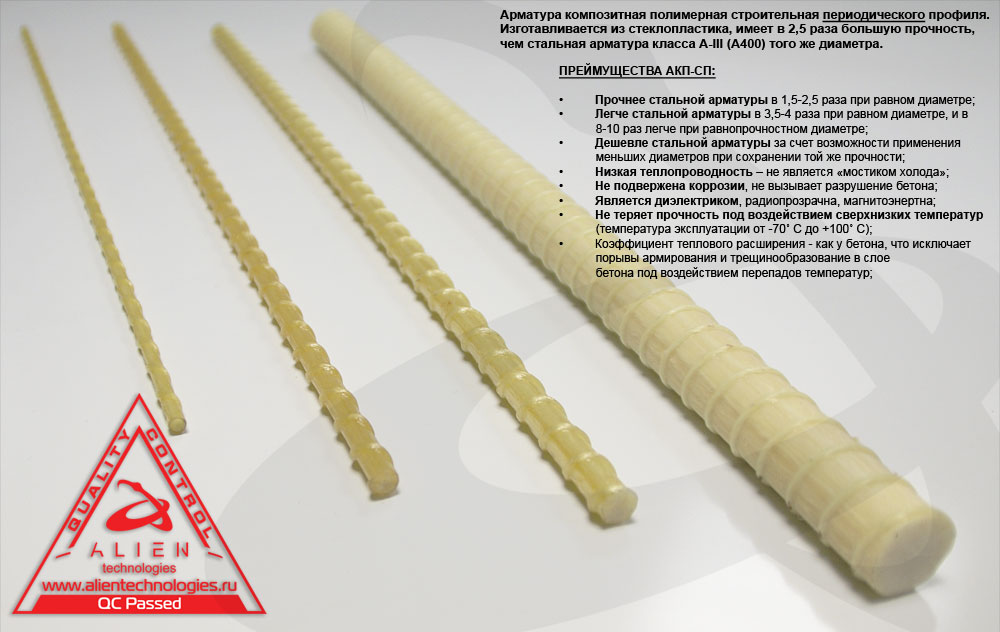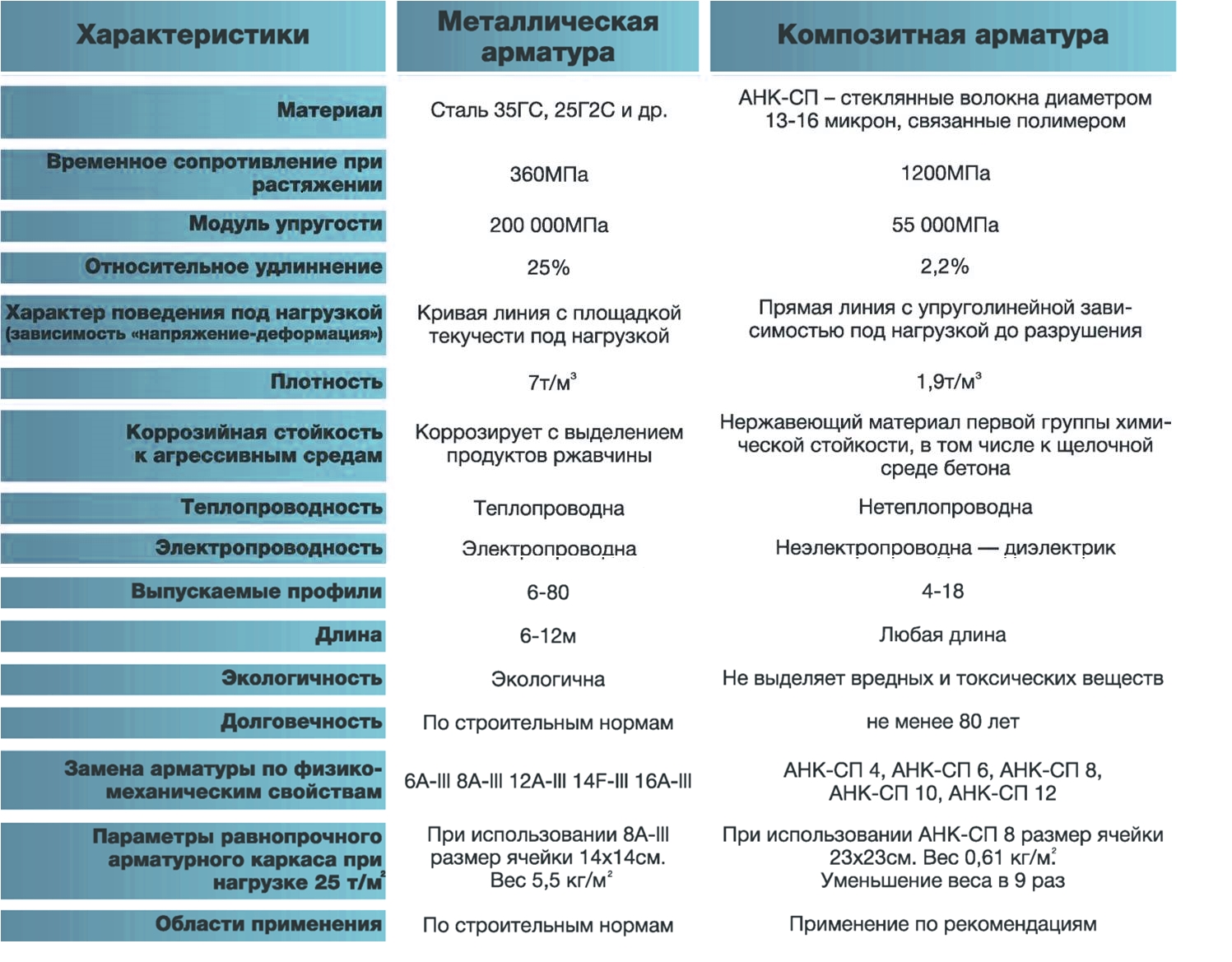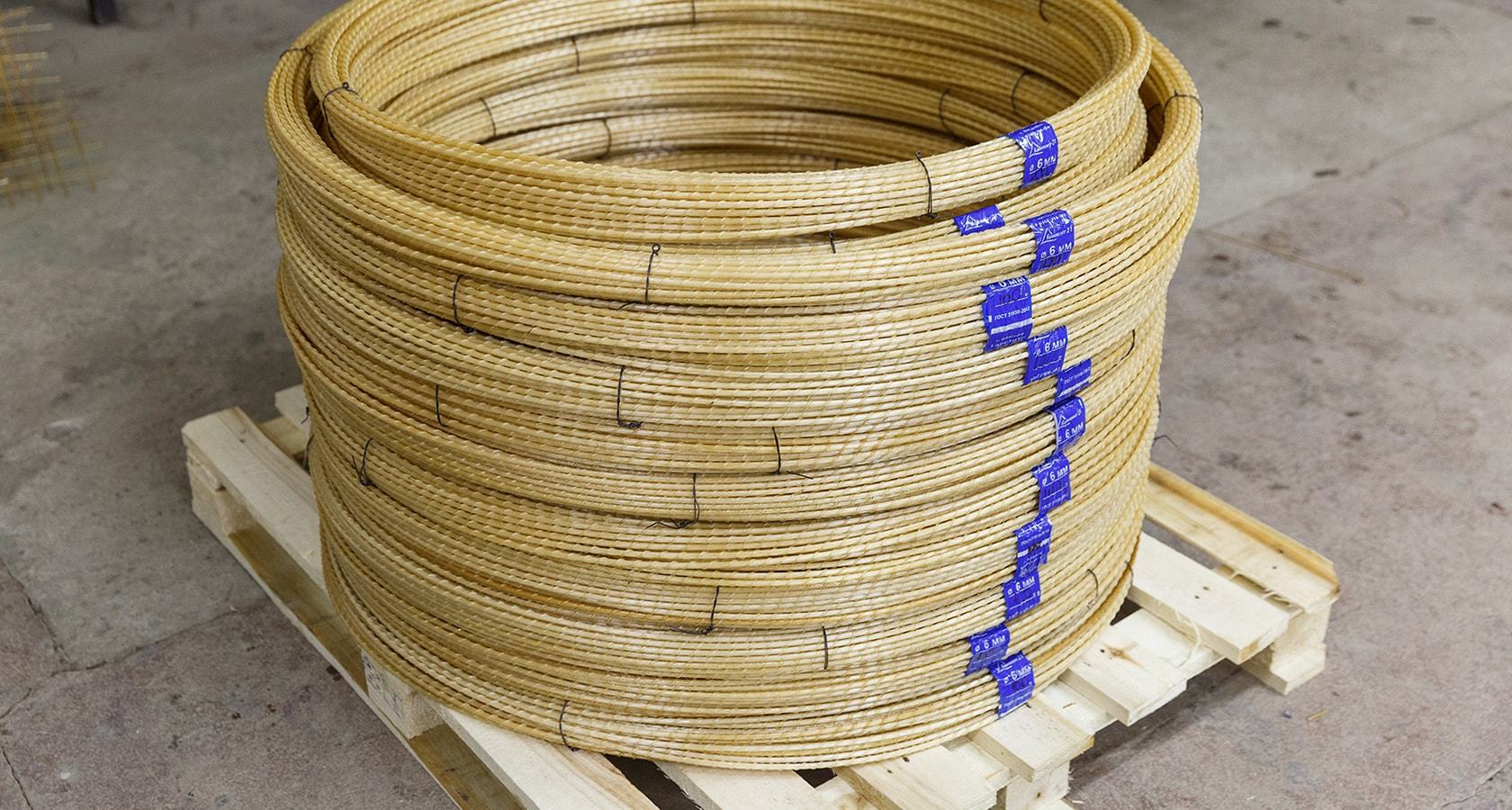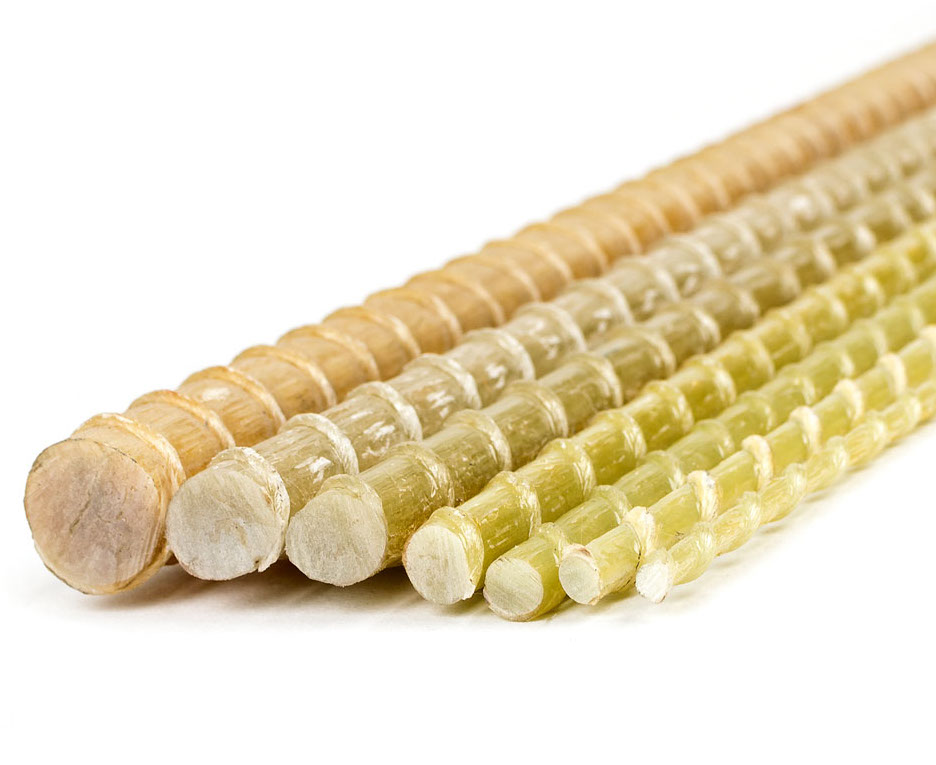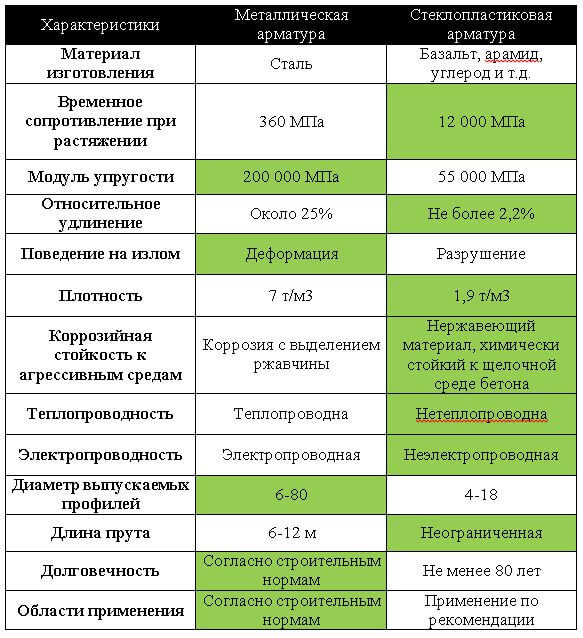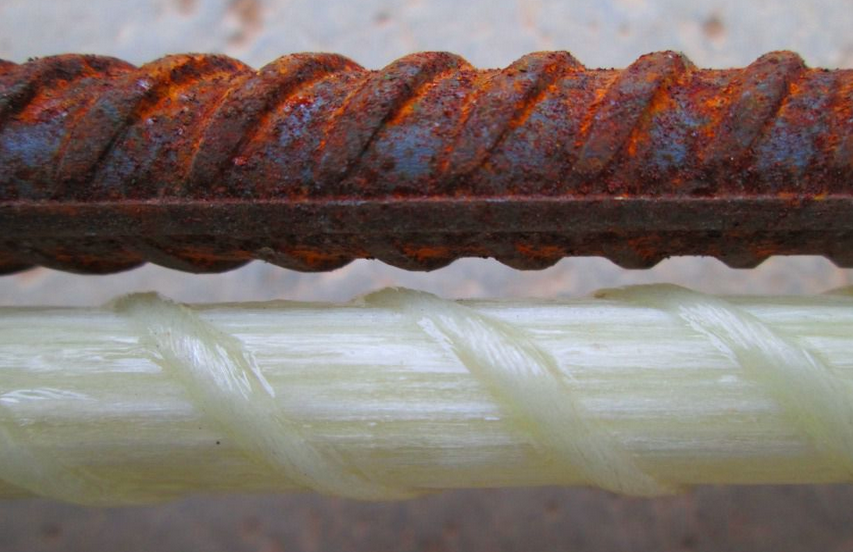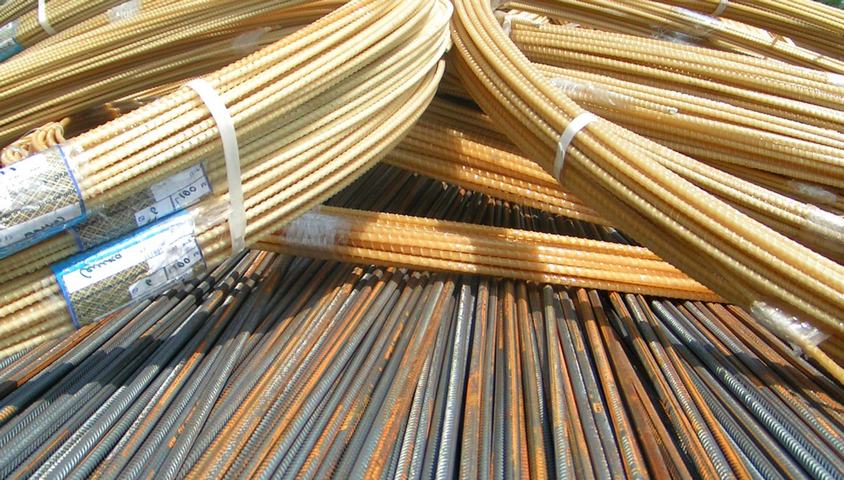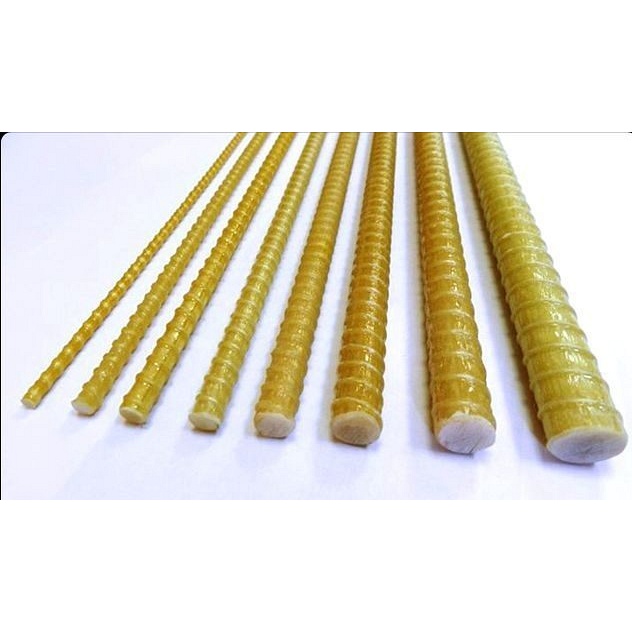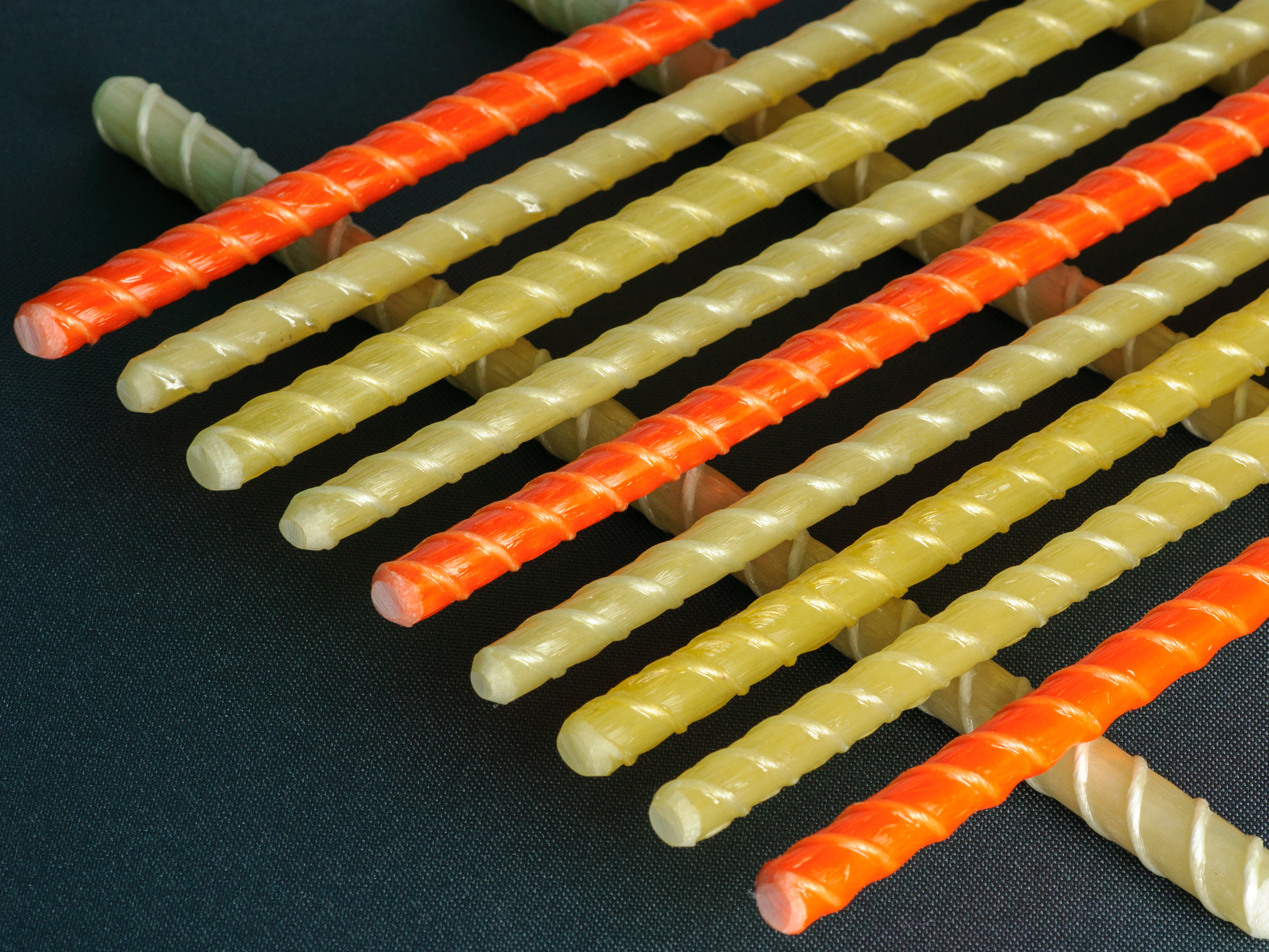What is fiberglass reinforcement
The reinforcement, for the production of which fiberglass materials are used, was developed a long time ago, back in the 1960s. However, due to its high cost, it was used only in harsh climates, where conventional steel reinforcement structures, subject to corrosion, could not last long. The reinforcement, which was made of fiberglass materials, was mainly used to strengthen the supports of bridges and other equally important structures operated in rather harsh climatic conditions.
Over time, the development of the chemical industry has contributed to a significant reduction in the cost of fiberglass reinforcement. This made it an affordable material that performs well in building structures for various purposes. The active use of this type of fittings led to the fact that in 2012, experts developed and approved GOST 31938-2012, the provisions of which stipulate not only the requirements for the production of this material, but also the methods of its testing.
GOST 31938-2012 Polymer composite reinforcement for reinforcing concrete structures. General specifications
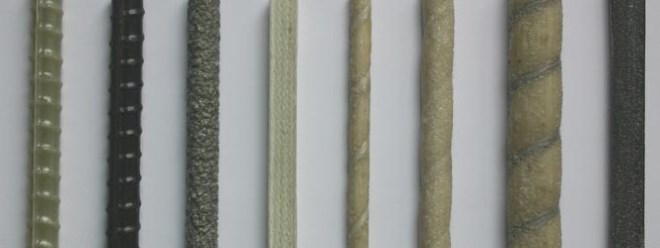
The surface of the fiberglass reinforcement can be corrugated, smooth or coated
In accordance with the state standard, fiberglass reinforcement is produced in the range of diameters 4–32 mm. However, the most common diameters for this type of products are 6.8 and 10 mm. Such fiberglass reinforcement products are supplied to the customer in coils.
Advantages and disadvantages of fiberglass reinforcement
Reinforcing frames made not of traditional metal, but from fiberglass elementshave the following advantages.
- Unlike metal structures, they are lightweight structures that do not create a significant load on the foundation of the structure, which makes it possible to extend its service life.
- Fiberglass elements of reinforcing cages, unlike their metal counterparts, better withstand tensile loads, which makes it possible to use them when strengthening the most critical concrete structures. Fiberglass reinforcing cages are characterized by the optimal ratio of their light weight and high strength, which allows them to be attributed to a separate group of building materials that are gaining more and more popularity every year.
- Unlike metal reinforcement, which is susceptible to oxidative processes and over time reduces the strength of foundation structures, frames made of fiberglass elements do not lend themselves to the influence of such negative environmental factors.
- Parts of reinforcement systems made of fiberglass are dielectric and do not conduct electric current, which also affects their durability. Metal reinforcing structures used as grounding elements oxidize much faster under the influence of electric current, which cannot be said about bars made of composite materials. Naturally, fiberglass reinforcement cannot be used as a grounding element, but this only has a positive effect on its durability.
- The wear resistance of the fiberglass reinforcing structure, like that of steel, is also at a fairly high level.
- The coefficient of thermal expansion of the reinforcement cage made of fiberglass elements is very close to that of concrete structures, which significantly reduces the risk of cracking in them when using such a material.

The ratio of the diameters of the rods when constructing the reinforcing frame of the foundation
Judging by the reviews, the following disadvantages of fiberglass reinforcement can be distinguished.
- Compared to metal products, fiberglass reinforcement has a significantly higher modulus of elasticity, which is approximately 4 times higher than that of steel products. This fact means that fiberglass elements, in comparison with metal ones, will bend much better under the influence of mechanical loads. When using these elements to reinforce the roadway and foundation, this characteristic is not critical, but to strengthen floor slabs it is better to use metal structures or make additional calculations.
- Reinforcing elements made of fiberglass have the property of strongly softening and losing their elasticity when heated to a temperature of 600 degrees. Therefore, when using fiberglass parts, it is better to take care of reliable thermal insulation of the frame made of composite materials.
- Reinforcing bars made of fiberglass cannot be welded, unlike metal ones, so if there is a need for such an operation, it is better to use products, into the inside of which a steel tube is mounted at the stage of their production.
- It is better not to bend the reinforcement made of composite materials on the construction site, as this may damage it. Such an operation, guided by the drawings of the reinforcement cage, is best performed at the production site.
- The complexity and installation technology unusual for modern builders is another drawback of reinforcing elements made of fiberglass. Meanwhile, such a disadvantage cannot be considered too significant, given the reliability and durability of fiberglass structures.
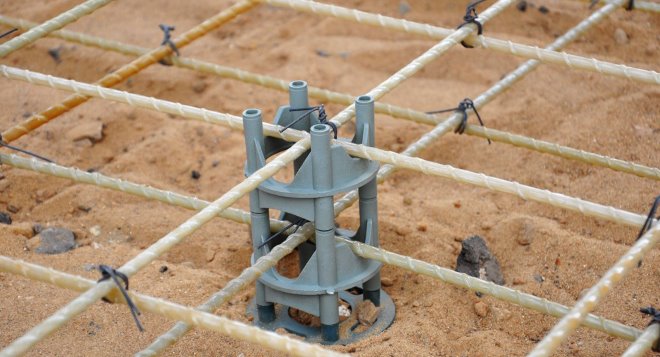
Fastening fiberglass reinforcement using clamps and clamps
Views
Fiberglass rebar is classified according to the types of materials used in the production. These are non-metallic raw materials of mineral or artificial origin. The industry offers the following types:
- Glass composite (ASP) - is a thermally treated mixture of longitudinally arranged fiberglass and polymer resins.
- Basalt rebar or basalt composite (ABP) - is made of basalt fibers, interconnected with organic resins.
- Carbon fiber reinforcement or carbon composite (AUK) - has increased strength and is made from hydrocarbon compounds. It is more expensive than composite.
- Aramid composite (AAK) - based on polyamide fibers, like nylon threads.
- Combined composite (ACC) - based on a fiberglass rod, on which basalt plastic is tightly wound. This type is not basalt-plastic reinforcement, with which it is confused, since it has a fiberglass rod.

| Index | ASP | ABP | AUC | AAK |
|---|---|---|---|---|
| Tensile strength, MPa | 800-1000 | 800-1200 | 1400-2000 | 1400 |
| Tensile modulus, GPa | 45-50 | 50-60 | 130-150 | 70 |
| Compressive strength, MPa | 300 | 300 | 300 | 300 |
| Tensile strength at cross section, MPa | 150 | 150 | 350 | 190 |
Manufacturers offer a large selection of fiberglass reinforcement in thickness. This makes it possible to make both a thin mesh of 4 mm and a strong reinforcing frame with a diameter of 32 mm for the supporting structure. It is supplied in the form of threaded whips or in coils up to 100 m long.
This material is available in two types of profile:
- Conditionally smooth. Made from the main rod with a layer of fine quartz sand sprayed, which improves adhesion to the concrete mixture;
- Periodic. It is made of a rod, on which a fiberglass bundle is tightly wound, as a result of which anchor ribs appear on the rod, which reliably hold it in the thickness of the concrete.
Composition of metal and fiberglass products
Steel reinforcement has been produced and used for a long time; today, many of its types have been developed. They are usually classified according to the following parameters:
- profile configuration;
- the loads that the product can take;
- method of load distribution;
- principle of operation;
- production technology.
In the manufacture of reinforced concrete structures, the following options for steel reinforcement are most often used:
- Working. The rods perfectly take all tensile loads and withstand sliding forces optimally.
- Distribution. These rods hold the reinforcing structure in a certain position, and evenly distribute the loads between its parts.
- Mounting room. It is used to form the frame.
- Anchor. This type is used as embedded structures.
According to the accepted loads, reinforcing products are subdivided:
- Longitudinal. It is designed to relieve tensile loads, it prevents the appearance of cracks in the vertical direction, including in "narrow places".
- Transverse. This type prevents the formation of inclined discontinuities, which are formed in the zone of the supports from sliding stresses.
By the way the loads are distributed, they are distinguished:
- single rods;
- frames;
- reinforcing mesh.
According to the manufacturing technology, metal fittings are classified:
- wire
- rods
- ropes
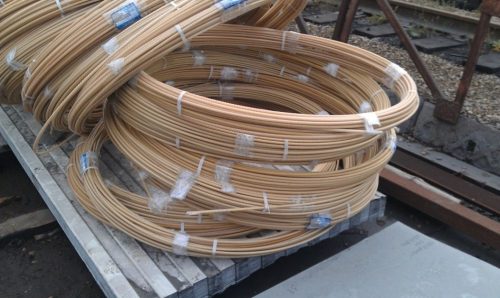 Fiberglass or metal reinforcement must be classified according to operational parameters. And it is customary to distinguish composite products by the type of material used in the manufacture of fibers, in addition to fiberglass:
Fiberglass or metal reinforcement must be classified according to operational parameters. And it is customary to distinguish composite products by the type of material used in the manufacture of fibers, in addition to fiberglass:
- basalt;
- aramid;
- carbon.
The fibers are impregnated with polymer. Epoxy resin is used more often in production. The rods are sent to the oven for drying. After that, the product is ready, it can be used in the production of reinforced concrete structures. The diameter of the rods can vary from 0.4 to 1.8 cm, the length of standard rods can be up to 12 meters. Spiral ribs are formed on the surface of fiberglass products, like metal products, for reliable connection with reinforced concrete.
Features of fiberglass
A reinforcement made of fiberglass is a rod, the diameter of which can be in the range of 4–18 mm, and the length can be up to 12 meters. It is made of heavy-duty plastic. Spiral ribs are applied to the surface of such a bar during its manufacture, due to which its reliable adhesion to concrete structures is ensured.
Plastic reinforcement, when compared with metal products of a similar purpose, due to its strength characteristics and corrosion resistance, allows you to create more reliable and durable frame structures, which explains the popularity that this material is actively gaining.
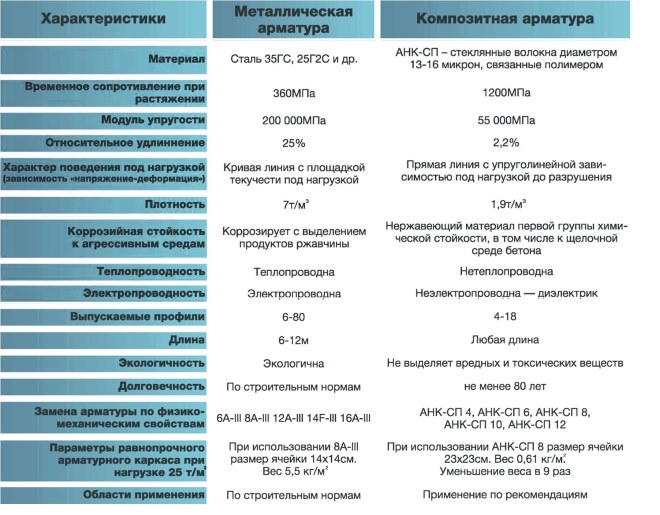
Comparison of characteristics of metal and composite reinforcement
It is also important that reinforcement made of fiberglass, in contrast to metal products, requires special production conditions, the use of high-quality raw materials and special equipment, therefore, its manufacture in artisanal conditions is excluded. That is why, when purchasing reinforcement made of fiberglass in the modern construction market, you can be sure that this is a material made in full compliance with the requirements of the relevant regulatory document.
The unique characteristics that distinguish reinforcement made of fiberglass are explained by the properties of its structure, which includes:
- an internal bar that ensures the strength of the reinforcement; such a rod is made of parallel fiberglass fibers securely connected by a polymer resin;
- the outer layer, which is a fibrous body wound in a spiral around the inner rod; this fiberglass layer can be sand-sprayed or bi-directional.

Fiberglass reinforcement is better than steel, it works in compression by 30%, and in tension by 20%
Foundation reinforcement technology
Due to the reduced weight of plastic reinforcement and the possibility of using rods of any length, the assembly of the reinforcing frame is much easier than from metal rods. Increased strength of the polymer reinforcement for foundations materials allows you to use a smaller section.
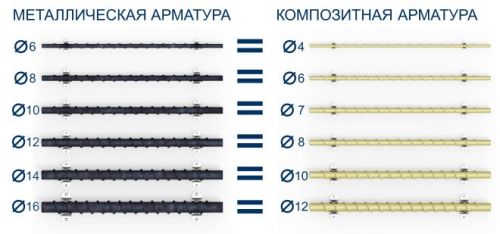 So, for example, steel reinforcement with a diameter of 12 mm, which is often used for the installation of foundations in private construction, is replaced with 8 mm plastic, and 10 mm rods - with 7 mm polymer.
So, for example, steel reinforcement with a diameter of 12 mm, which is often used for the installation of foundations in private construction, is replaced with 8 mm plastic, and 10 mm rods - with 7 mm polymer. A calculation table that will help you determine exactly which diameter can be used in each individual case.
A calculation table that will help you determine exactly which diameter can be used in each individual case.
The technological process for the production of installation work using plastic reinforcement for the foundation is carried out in several stages, which is shown in the video at the end of the article:
- installation of formwork;
- marking the level of concrete pouring;
- assembly of the reinforcing frame;
- pouring concrete;
- removal of the formwork.
The installation of the formwork structure when reinforcing the strip foundation with fiberglass reinforcement should be carried out in accordance with the project to ensure the exact configuration and dimensions of the foundation elements. When arranging formwork from wooden boards, chipboard or plywood, it is recommended to wrap the boards with glassine. This will save the material and reuse it.
After that, on the inside of the enclosing elements using a water level, it is necessary to mark the upper level of the future monolith. They will allow you to orient yourself when pouring concrete and ensure its even distribution.
Assembling the reinforcing frame
Reinforcement layouts and dimensions between individual rods are always indicated in the project. In the case of using fiberglass reinforcement in the foundation, you can change the diameter of the rods to a smaller one, but the layout should only be performed according to the drawing.
 Reinforcement scheme for a monolithic slab.
Reinforcement scheme for a monolithic slab.
Initially, it is necessary to unwind rods of the required length from the coil and install them on supports parallel to each other. Place transverse bridges on the longitudinal strings at specified intervals. Tie the reinforcement at the intersection with a knitting wire or pull it off with lingering plastic clamps (for more details on knitting - here). As a result, the bottom row of the frame will be ready for reinforcing the foundation with fiberglass reinforcement.
Prepare vertical posts of the required length. The upper row of the frame is knitted in the same way as the lower one. After assembly, both rows are placed on top of each other and, starting from the edge, their vertical posts are connected, gradually raising the upper row of reinforcement.
 After assembling the structure, it must be moved and installed inside the formwork fence, as shown in the photo.
After assembling the structure, it must be moved and installed inside the formwork fence, as shown in the photo.
Before installing the reinforcing frame, sand is poured into the bottom of the trench and spilled with water or rammed. It is recommended to cover the compacted sandy surface with a waterproofing material or geotextile cloth. This will prevent moisture from entering the foundation and increase its reliability and service life.
In the process of performing work on the installation of a foundation made of fiberglass reinforcement, it must be remembered that the edges of the rods should not reach the formwork and the bottom of the trench by 5 cm. materials.
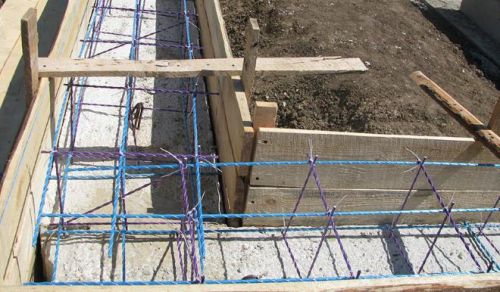 Reinforcement of the belt.
Reinforcement of the belt.
Pouring concrete mix
Placement of concrete inside the formwork is done in the same way as when using metal reinforcement
However, great care should be taken as the strength of the fiberglass reinforcement may be insufficient under strong lateral impacts. Compaction of concrete with a vibrator or rammer must be performed in such a way as not to damage the installed frame
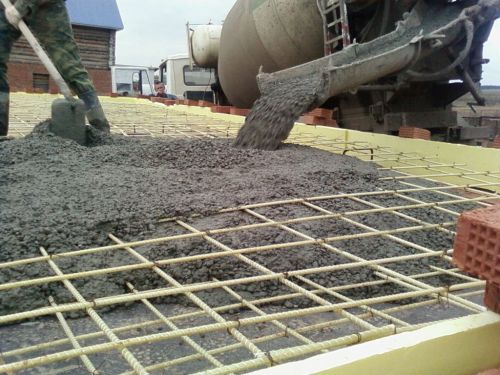
2 Flexural strength
The parameter depends on the modulus of elasticity of the material. For steel grade St3 its value is 200 GPa (gigapascals), for fiberglass - 30–55 GPa. This means that in structures where the reinforcement works for bending (all types of floating foundations, slabs and floor beams, lintels over openings and crossbars of the building frame), the diameter of the fiberglass reinforcement should be larger than the steel one. How much? This requires the calculation of a specific design. The problem is that the method of such a calculation was developed only for reinforced concrete (SP 63.13330.2012), but for concrete with composite reinforcement it is not.
How are composite rebar made?
Let's start with the fact that the term "composite reinforcement" unites all types of non-metallic reinforcement, produced on the basis of different types of fibers, which are used as the reinforcing base of the rod. The fibers from which the reinforcement is made can be as follows:
- 1. basalt fiber;
- 2. glass fiber;
- 3. aramid fiber.
- 4. carbon fiber.
Thus, the types of composite reinforcement, depending on the applicable fibers, are as follows:
1. Basalt plastic reinforcement, usually black (ABP);
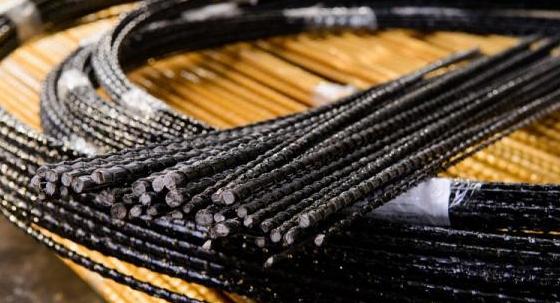
2. Fiberglass reinforcement, light yellow, however, thanks to the coloring additives, the color gamut is wide (ASP);

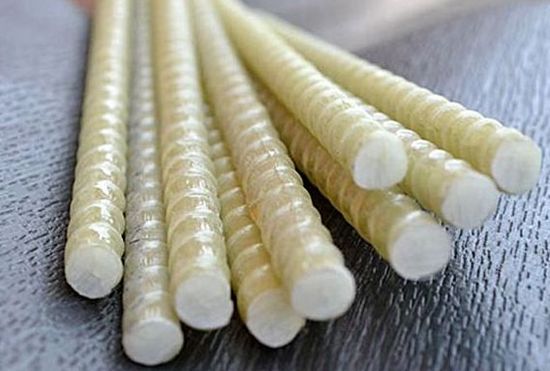
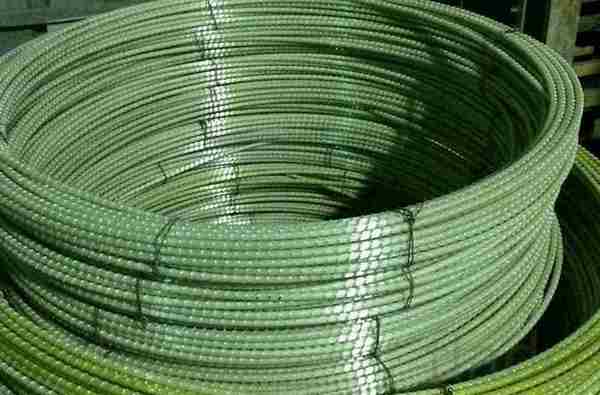
5. Combined reinforcement (based on different types of fibers).
Any composite reinforcement is produced on the same equipment, the technology does not differ either. The only difference is in the type of fibers. Currently, there are several production methods:
1. A bundle of fibers, having previously formed a bar - the main rod of the reinforcement, is impregnated with epoxy resin and pulled out. Then the bundle of fibers is pulled by the shafts, while winding around it a tourniquet made of the same fibers using resins. The rope in this process performs two tasks - it tightly presses the fibers of the rod, and serves as reinforcement ribs, which will improve the adhesion of reinforcement and concrete in the future. After that, the fittings undergo a drying stage in the oven, and now, the fittings are ready. This method is the oldest, almost all Russian manufacturers of plastic fittings use it.

1.Fiber feeding system (fiberglass, carbon fiber, basalt fiber)
2.Polymer bath (polyester, epoxy resin)
3. Preforming device
4.Filiere
5.Zones of heating / cooling of the die
6.Pulling machine
7.Cutting machine
2. The second method differs from the first only in that the rope is wound onto the rod with a very strong force, it is literally pressed into the main rod, as a result of which the ribs are formed from the fibers of the rod itself. Such reinforcement is more durable than the one produced by the first method, since there is no risk of ribs falling off. However, it is almost impossible to find such Russian-made fittings, since most of them use the first method.
3. The third method is also similar to the first one, however, the tightening rope does not form ribs here, but only tightens the fibers of the bar until the moment of polymerization in the oven. For adhesion to concrete, a layer of abrasive is applied to the reinforcement - quartz sand. This type of reinforcement has the worst adhesion to concrete, and, moreover, the shortest service life. The fact is that epoxy resin quickly degrades in an alkaline environment of concrete, and polyester resins, which are not afraid of alkali, are extremely rarely used by manufacturers in Russia.
4. Finally, pultruded reinforcement. In this case, the fibers are formed into a rod, impregnated with polymer resins, and pulled through dies with different sections, located in descending order. This method allows the formation of periodic relief (ribs) with high accuracy, so that they can be used as a thread (for example, as a tightening screw for formwork, with a fiberglass or steel nut). The fittings produced in this way are of high quality, durability and high price.In addition, such fittings are almost never produced in Russia.
If you search, you can find on sale a completely unusual material - composite reinforcement with an internal cavity
Despite its exoticism, the tube reinforcement deserves attention - after all, thanks to the cavity, the diameter increases, and with the same number of fibers, the reinforcement with the cavity has a larger area of contact with concrete, which means better adhesion
6 Usability
According to this parameter, fiberglass reinforcement differs little from steel. It is much lighter, but for individual low-rise construction, the mass of the reinforcement is insignificant. Fiberglass cannot be welded, but today they also prefer to knit steel reinforcement with stainless wire or plastic clamps. It is very easy to cut composite rebar with a grinder. The only important nuance: a fiberglass rod cannot be bent on a construction site, and bent products ordered from the manufacturer will be expensive, and besides, they will have to wait a long time. The absence of rigid continuous reinforcement in the corners can affect the strength of the structure, but there is a way out: nothing prevents the combination of straight fiberglass rods with bent steel rods.
Main advantages
Among the advantages that distinguish carbon fiber reinforcement are the following.
An important advantage of fiberglass reinforcement is its low specific weight, which makes it possible to use it for reinforcing lightweight structures made of aerated concrete and some other building materials. This allows you to significantly reduce the weight of structures that are reinforced with it. Meanwhile, the weight of a conventional concrete structure when using fiberglass reinforcement will decrease slightly, since the building material itself has an impressive mass.
Low thermal conductivity is also one of the advantages of fiberglass reinforcement. When using such reinforcement in concrete structures, cold bridges are not formed (which cannot be said about reinforcing metal elements), which significantly improves their thermal insulation parameters.
The high flexibility of fiberglass reinforcement allows it to be shipped to the customer in coils, and not cut into separate rods. Due to the compact form of packaging, it is much easier to transport such fittings, for which you can use the trunk of any car, and this significantly reduces the cost of delivering material to the place of construction work. The use of reinforcing elements, which are shipped not in cut rods, but in coils, also allows you to reduce material costs by reducing the number of overlaps
This positively affects both the strength characteristics of the future concrete structure and its cost, which is especially important when performing construction work.
Such an advantage of fiberglass reinforcement as its durability inside a concrete structure is considered quite controversial. Metal fittings, being in an insulated state, are also not negatively influenced by external factors, which ensures the durability of its use.
CFRP is a dielectric material, which is the advantage of products made from this material.
Electrically conductive metal fittings are more susceptible to corrosion, which negatively affects their durability.
Compared to metal reinforcing elements, fiberglass products are not exposed to chemically active media. Such an advantage of fiberglass reinforcement is especially important in cases of erection of buildings in winter, when various salt solutions are added to the concrete, which accelerate the hardening process.
As a dielectric, CFRP does not generate radio interference inside a building, unlike metal rods. This advantage is important when there are many reinforcing elements in the concrete structure. Otherwise, the use of composite reinforcement will not be a disadvantage, but it will not be so relevant.

The main advantages of composite reinforcement
Fiberglass reinforcement also has disadvantages, which should also be known to its potential consumers.
Disadvantages of non-metallic reinforcement
There is no ideal in all materials, and composite reinforcement has a number of features that impose restrictions on its widespread use. Cons of non-metallic concrete structure elements:
- the modulus of elasticity of steel is 4 times higher than that of fiberglass, therefore, floor slabs and load-bearing structural elements are made of iron reinforcement;
- plastic cannot be welded, only knitting together or the use of fittings with metal tips;
- any composite rods cannot be bent at right angles, special corners are taken for connection or tied end-to-end with an overlap;
- mechanical properties deteriorate with heating, and at a temperature of 600 degrees, a complete destruction of the structure occurs;
- construction crews have little experience with composites and lack of certification for most of the objects under construction (metal reinforcement is set by default).

A combination of metal assemblies and plastic rods of various diameters will help to minimize the disadvantages. This mutual combination is considered optimal and reliable.
Features of production and installation
Any type of fiberglass reinforcement is made from raw fiber bound with polymer resins, to which a hardener and a hardening accelerator are added. All components are determined by the manufacturers depending on the technologies used, on the type and purpose of the elements that will be reinforced with the manufactured fiberglass reinforcement.
The material is produced on special technological lines. First, the fiberglass is impregnated with resin, a hardener and a reaction accelerator. After that, it is passed through a die, where excess resin is squeezed out. The fiberglass is immediately compacted and takes on a shape - conditionally smooth or with anchor ribs and a technologically specified diameter.
At the next stage, the composite fiberglass reinforcement is knitted - an additional winding in the form of a bundle is wound on it in order to increase adhesion. After that, it is sent to the oven, where polymer resins with a hardener set. The resulting products are stacked in coils or cut into whips of the required length.
Bars are fastened with plastic clamps or clamps. The edge of the reinforcing mesh should be 50 mm away from the formwork to create. This is done with improvised means or plastic clips. If the rod protrudes beyond the formwork, it must be cut with a hacksaw for metal or a grinder with a diamond or abrasive wheel.

It is impossible to bend fiberglass reinforcement on the site without special equipment. After the force ceases to act on the rod, it returns to its original shape. If you soften it with temperature, and still bend it, it will lose its design characteristics. The only way out is to order a pre-bent fiberglass element at the factory, in which case they will fully meet the technical and operational requirements.
Cons of composite rebar
Among the disadvantages of composite materials used when laying reinforcement, the following are distinguished:
- Low flexural elasticity. Due to the fact that plastic elements have a low modulus of elasticity, this can lead to deformation of the concrete structure.Well bending elements are difficult to use when. For comparison, the modulus of elasticity of the composite is 55,000 MPa, while for plastic this figure reaches 200,000 MPa.
- Small range of sizes. Today, when choosing steel reinforcement, consumers are offered a wider variety of products of different sections.
- Lack of SNiPs. Although fiberglass products are standardized in accordance with GOST, there is no other regulatory framework for building elements of this type. Based on this, the process of designing objects becomes more complicated, since it is still quite problematic to make calculations.
- Cannot be used in some regions. Plastic products are not recommended for the construction of facilities in areas where temperatures are too low in winter.
- Instability. complicated by the poor stability of the plastic rods. The structure begins to stagger, so you have to resort to "tricks" to fix the frame before pouring the concrete mixture.
- Quite high material cost. Fiberglass will cost 2 times more than steel counterparts.
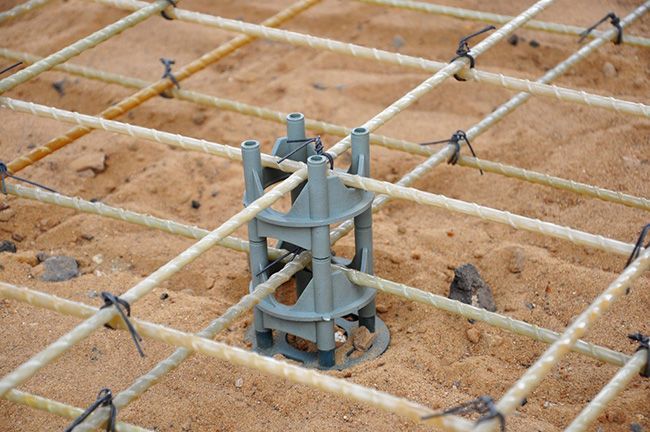
Speaking about plastic fittings, its pros and cons, many attribute to the disadvantages of these products such things as: the inability to use welding equipment and low resistance to heat. However, in reality, welding is practically not used when assembling the reinforcement cage. Equally absurd is the theory about the instability of a material to high temperatures. Fiberglass completely loses its properties when heated above 600 degrees, but not every concrete is able to withstand such a temperature.
Based on the foregoing, it becomes obvious that when reinforcing concrete structures, in order to determine which reinforcement is more suitable - metal or fiberglass, you need to clarify for what purposes you need a reinforced frame. On the one hand, the latest composite materials clearly benefit, but in terms of cost, it may be more profitable to purchase steel products.
In construction, as in other industries, they increasingly resort to using the latest technologies and innovative approaches in the production of goods and services. Fiberglass reinforcement is an example of such an alternative solution. She quickly replaced traditional metal parts, overtaking them in economic and technical parameters. From this article you will learn what fiberglass reinforcement is. The characteristics of this material will be presented in comparison with others.
Disadvantages of metal fittings
Main disadvantages:
- Corrosion susceptibility is the main disadvantage of this material. A choice of product variations from special corrosion-resistant compositions is possible, but this will have a significant burden on the construction budget. And it certainly won't help to get rid of other problems;
- Excessive weight is also a significant disadvantage. It increases the cost of material transportation, loading, unloading, storage;
- Fixed length - steel reinforcement is often carried in rods of fixed length. And a fiberglass analog can be bought in a bay of any length, which also eliminates the waste of materials and the appearance of scraps;
- Increased thermal conductivity - this factor leads to the formation of cold bridges in the foundation, which can have a significant effect on the strength indicators of the formed structure.
Price question
Comparing the two variations of fittings, one cannot ignore the issue of pricing policy. Yes, at first glance, the cost per meter of a fiberglass product is higher than that of a metal product. But there is one caveat. With the same strength, fiberglass reinforcement has a smaller cross-section than similar steel. Therefore, elements identical in their parameters will have approximately the same cost.
There is no unequivocal answer, which is better - metal or fiberglass. It all depends on the features of the facility being built and the technical conditions for its use.
New or just well forgotten old
So what kind of material is this - composite rebar? High strength polymer core with corrugated outer surface. Consists of non-metallic fibers, collected in a bundle, and epoxy or polyester resin, which acts as a binder.
Depending on the type of non-metallic fibers, the composite has its own specific name. Most often, fiberglass is used, such reinforcement is called fiberglass. Basalt and carbon fiber are less commonly used. Accordingly, the name of this type is basalt and carbon fiber.
Already in the middle of the last century, the use of fiberglass reinforcement was dealt with in many countries. The reasons are the fragility of steel reinforcement due to inevitable corrosion and not the infinity of iron ore reserves.
The outstanding Soviet scientist Burkov, one of the first in the world, already in 1941, put forward the idea of reinforcing concrete with fiberglass reinforcement. In the 1950s, the first pilot production of composite types of reinforcement was launched in the USSR.
In parallel, a whole cycle of research was carried out on prestressed bending elements with it. Technical rules for the manufacture of composite reinforcement were developed, a number of recommendations were made for the design of various concrete structures with its use, and areas of application were determined. In the sixties - seventies, fiberglass reinforcement was used in lightweight concrete structures, as well as in various types of foundations, beams, piles, girders, all kinds of slab structures to strengthen slopes, embankments, and so on.
Composite reinforcement (mainly fiberglass) was also used in the construction of bridges. For the first time in the world, a glued wooden bridge was built in 1975 in the Soviet Union. The spruce beams of this bridge were reinforced with four beams of prestressed fiberglass rods. In 1981, a bridge was built in Primorye with metal spans, prestressed with fiberglass rods. A bridge was erected with the reinforcement of structures with fiberglass reinforcement in the Khabarovsk region. Commissioned in 1989.
Composite reinforcement, for the manufacture of various structures, is widely used in other countries. Thus, Canada is the world leader in the use of composite types of reinforcement in the construction of bridge decks. In the USA, Japan and many European countries, it is widespread in the construction of modern highways, structures for various purposes, bridges and other facilities. In Japan, it is serially used in the construction of earthquake-resistant houses. Recently, China has become the largest producer and consumer of composite rebar.




